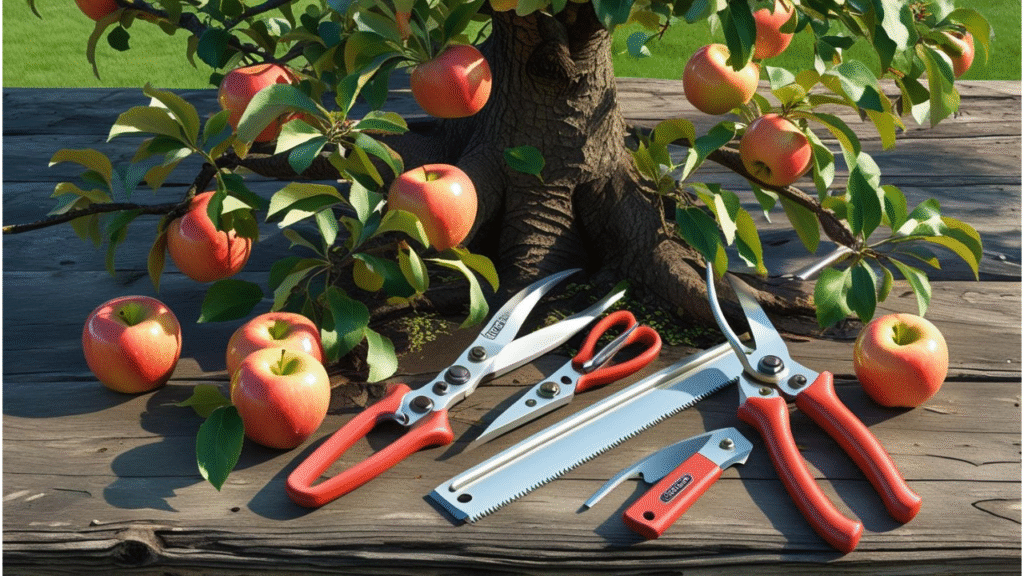
Top Apple Tree Pruning Tools: Essential Gear for Healthier, More Productive Trees
Are you ready to boost the health and productivity of your apple trees? 🌳 If you’ve ever struggled with sparse fruit, uneven growth, or an unruly tree, the solution might be simpler than you think. The secret lies in the right apple tree pruning tools. Using the proper tools can transform your pruning routine, helping you shape your tree, remove diseased branches, and maximize fruit yield. Whether you’re a seasoned gardener or a beginner, having the right equipment is essential to achieving the best results.
In this guide, we’ll walk you through the top apple tree pruning tools you need for healthier, more fruitful trees. By the end, you’ll have the knowledge and confidence to make smarter choices when it comes to maintaining your orchard. Keep reading to discover how these tools can make your pruning sessions faster, easier, and more effective! 🍏✨
Table of Contents
Toggle🌳✨ Why Pruning is Crucial for Apple Trees ✨🌳
Pruning ✂️ your apple tree 🌳 isn’t just about giving it a neat appearance 🎨—it’s an essential practice 🧑🌾 that promotes healthy growth 🌱 and a bountiful harvest 🍏. If you want your tree 🌳 to thrive 🌱, pruning should be a top priority 🔝. Here’s why it matters:
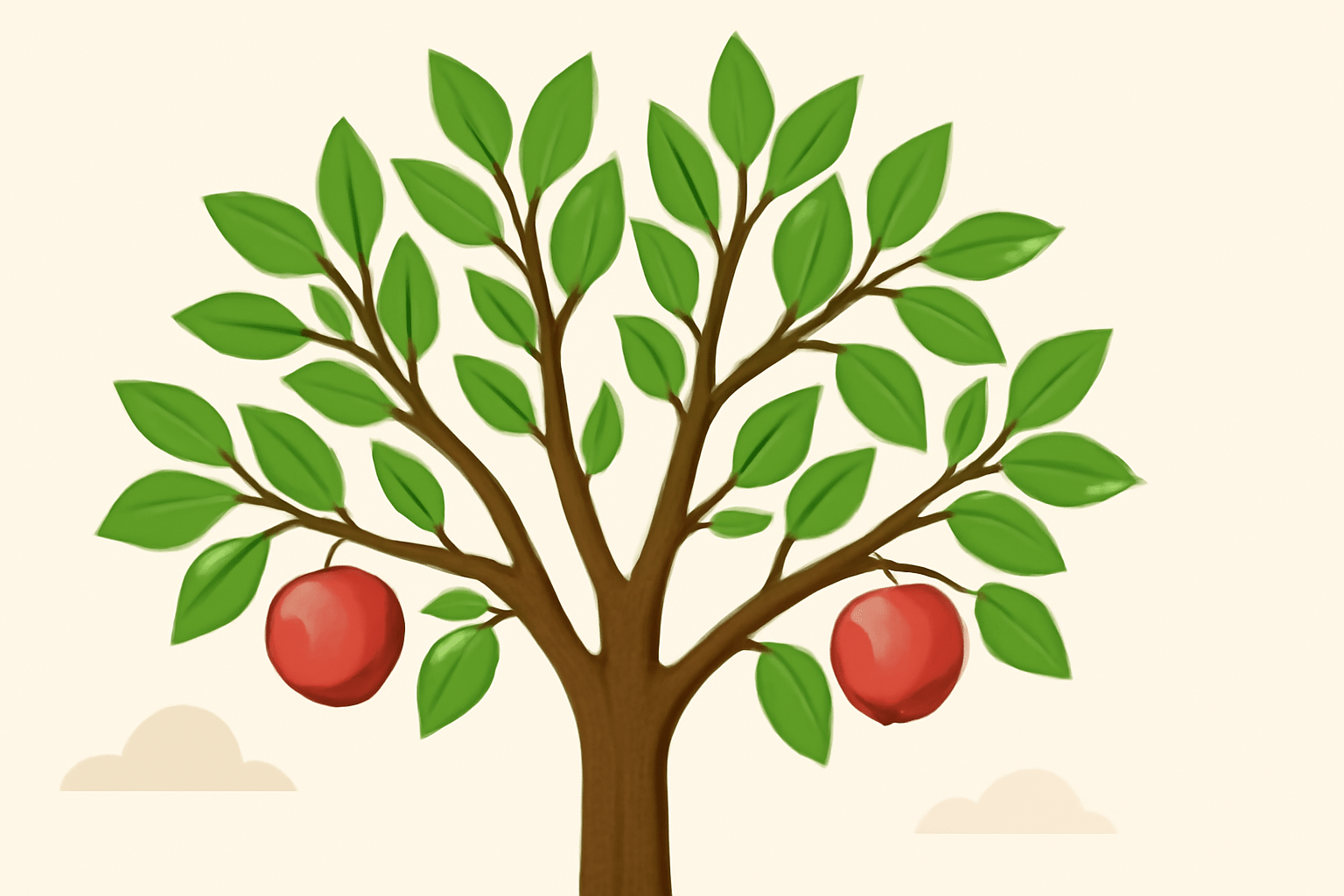
🍏 Encourages Healthier Growth 🌱
Pruning ✂️ helps your apple tree 🌳 focus its energy 💥 on the most important branches 🌿. By cutting away dead ❌, damaged 🦠, or diseased wood 🍂, you reduce the risk ⚠️ of pests 🐜 and diseases 🦠 taking hold. This allows your tree 🌳 to channel its resources 💪 into strong, healthy branches 🌿 that will support fruit 🍏 production.
🌿 Increases Fruit Yield 🍏
Proper pruning ✂️ opens up space 🌞 for sunlight ☀️ and air 🌬️ to reach the inner parts of the tree 🌳, promoting better photosynthesis 🌿. As a result, your tree 🌳 can produce more fruit 🍏. Pruning ✂️ also helps remove competing branches 🌿 that may be blocking each other ❌, ensuring that the remaining branches 🌿 are more productive 💪 and capable of supporting larger, tastier apples 🍏.
🍎 Improves Tree Shape and Structure 🌳
Shaping ✂️ your tree 🌳 not only makes it look beautiful 🎨 but also helps it grow 🌱 in a more balanced way ⚖️. By removing overcrowded branches 🌿 and trimming ✂️ those that grow inward ↩️, you improve airflow 💨 and prevent limbs 🌿 from rubbing against each other 🤝, which could lead to damage 💔. A well-pruned tree 🌳 is easier to manage 🧑🌾, making future pruning ✂️ tasks less overwhelming 😌.
In short, regular pruning ✂️ helps you maintain a strong 💪, productive 🍏 apple tree 🌳. When done right ✅, it leads to healthier growth 🌱, more fruit 🍏, and a tree 🌳 that stands tall 💪 and strong 🌳 throughout the seasons 🗓️! 🌱
✂️🍏 Essential Apple Tree Pruning Tools 🍏✂️
Pruning your apple tree 🌳 requires more than just a pair of scissors ✂️. Using the right apple tree pruning tools 🛠️ is key to making the job easier 🏃♂️ and more effective 💪. Here’s a rundown 📋 of the essential tools 🧰 you’ll need to maintain a healthy 🌱, productive 🍏 apple tree 🌳:
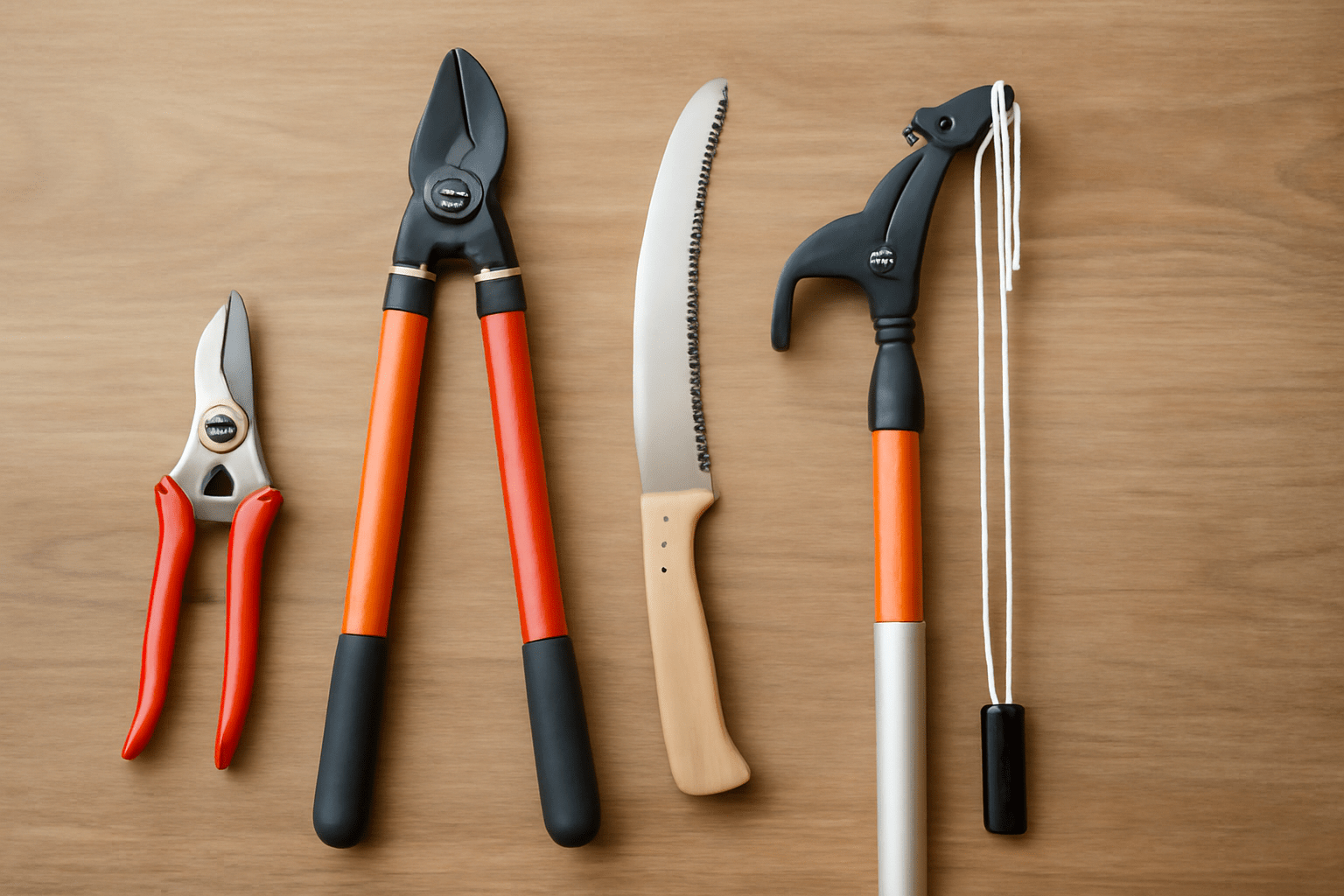
🌿 Pruning Shears (Hand Pruners) ✂️
Best for: Cutting small branches 🌿, twigs 🌱, and deadwood 🌿.
Why You Need Them: These are your go-to tool 🧰 for precise cuts ✂️ on small branches 🌿 (under ¾ inch in diameter). They are lightweight 💨 and easy to use, making them perfect for detail work 🖊️ around your tree 🌳.
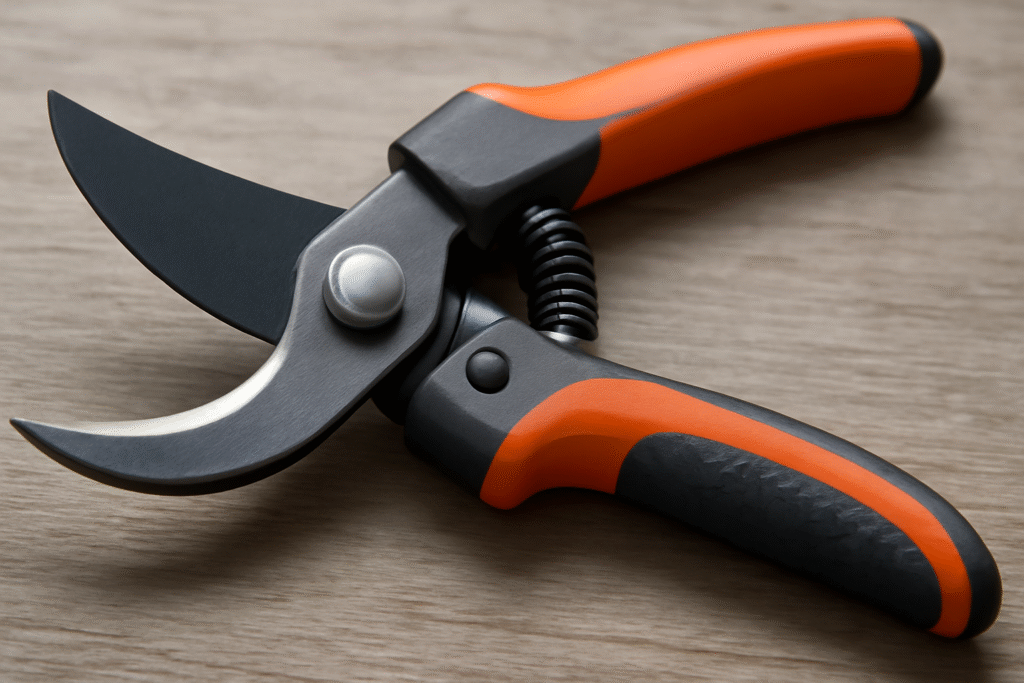
Features to Look For:
- Sharp, durable blades 🔪.
- Comfortable, ergonomic handles 🤲 to reduce hand fatigue 🦾.
- Adjustable tension ⚙️ to customize cutting force 💪.
Recommended Brands: Felco, Fiskars.
🌳 Loppers 🌿
Best for: Cutting thicker branches 🌿 (up to 2 inches in diameter).
Why You Need Them: Loppers give you extra leverage 🏋️♂️ when dealing with medium-sized branches 🌳. They are more powerful 💪 than pruning shears ✂️, with longer handles 🔧 that help you reach and cut with ease ✂️.
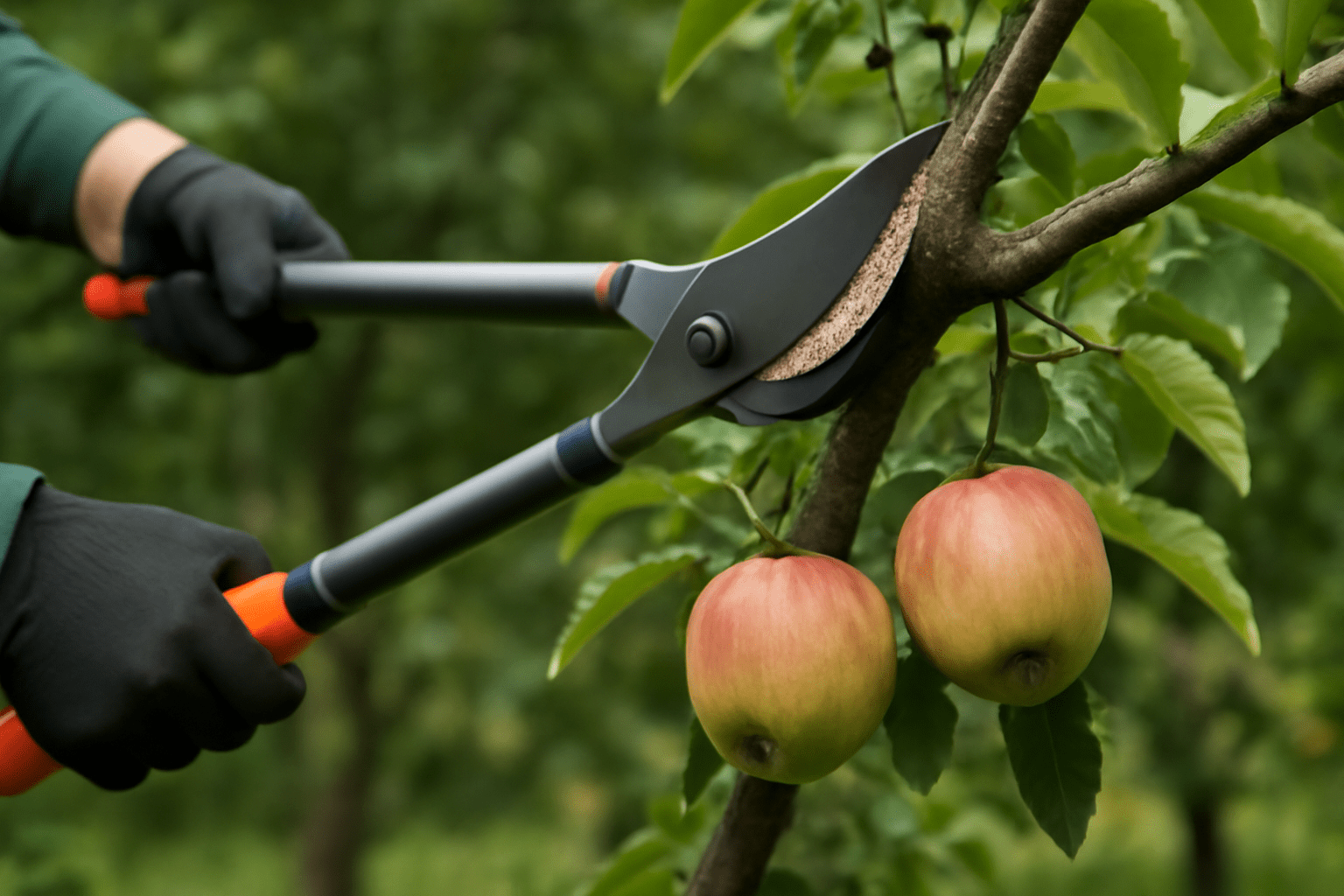
Features to Look For:
- Long handles 📏 for increased cutting power 💥.
- Ratchet or gear mechanisms ⚙️ for easier cutting of thick branches 🌳.
Recommended Brands: Corona, Fiskars.
🌱 Pruning Saws 🪚
Best for: Cutting branches 🌳 over 2 inches in diameter.
Why You Need Them: When branches 🌿 become too thick for pruning shears ✂️ or loppers 🌿, a pruning saw 🪚 comes in handy. These saws allow you to make clean cuts through larger, more stubborn branches 🌳.
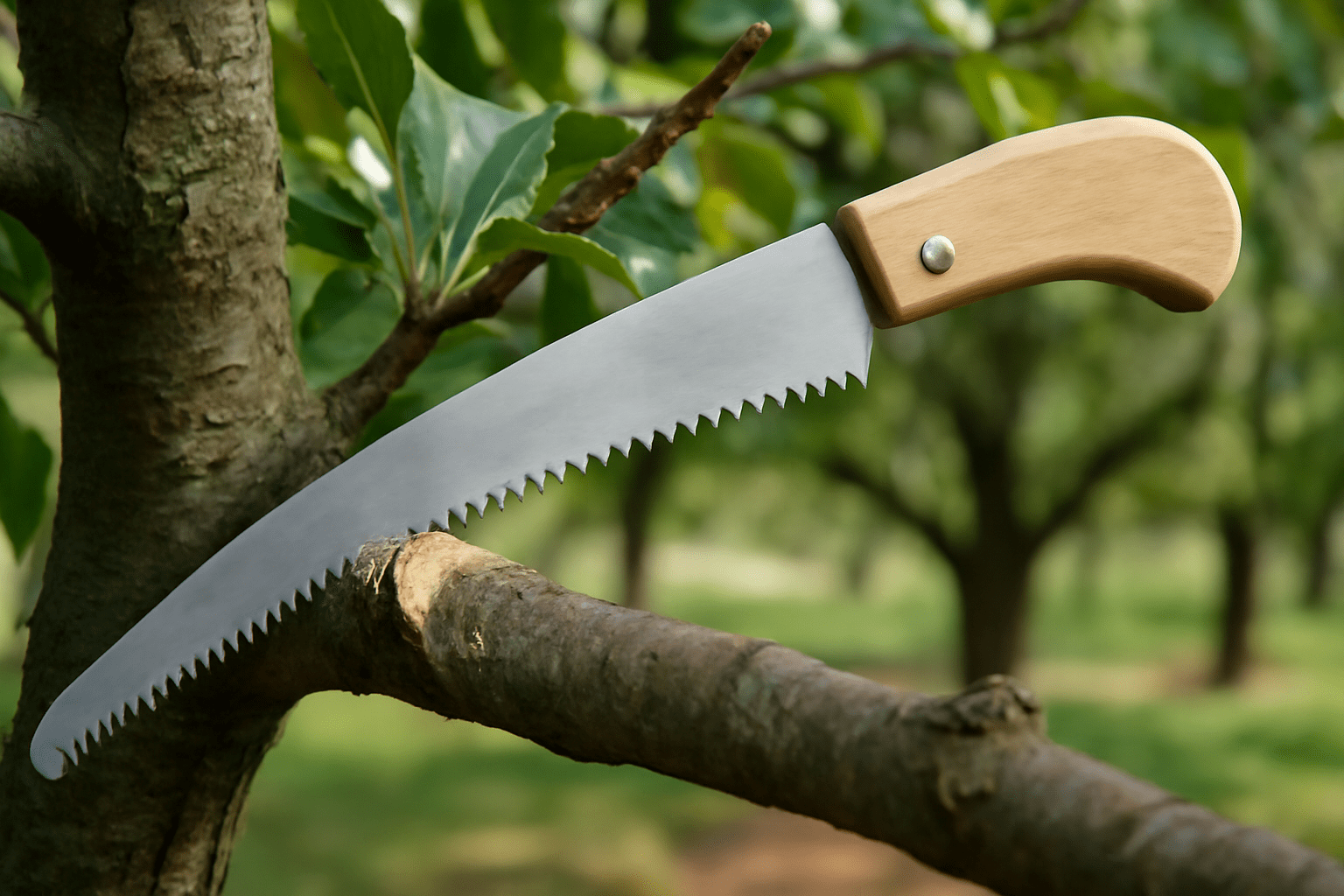
Features to Look For:
- Curved or straight blades 🔪 for better cutting action ⚡.
- Comfortable grip 🖐️ for precision and safety 🦺.
- Rust-resistant materials 🦠 for durability 💪.
Recommended Brands: Silky, ARS.
🌳 Pole Pruners 🪓
Best for: Reaching high branches 🌳.
Why You Need Them: Pole pruners 🪓 are ideal for trimming branches 🌳 that are out of reach. These extendable tools 🧰 allow you to prune without a ladder 🪜, reducing risk ⚠️ and making it easier to access high spots 📍.
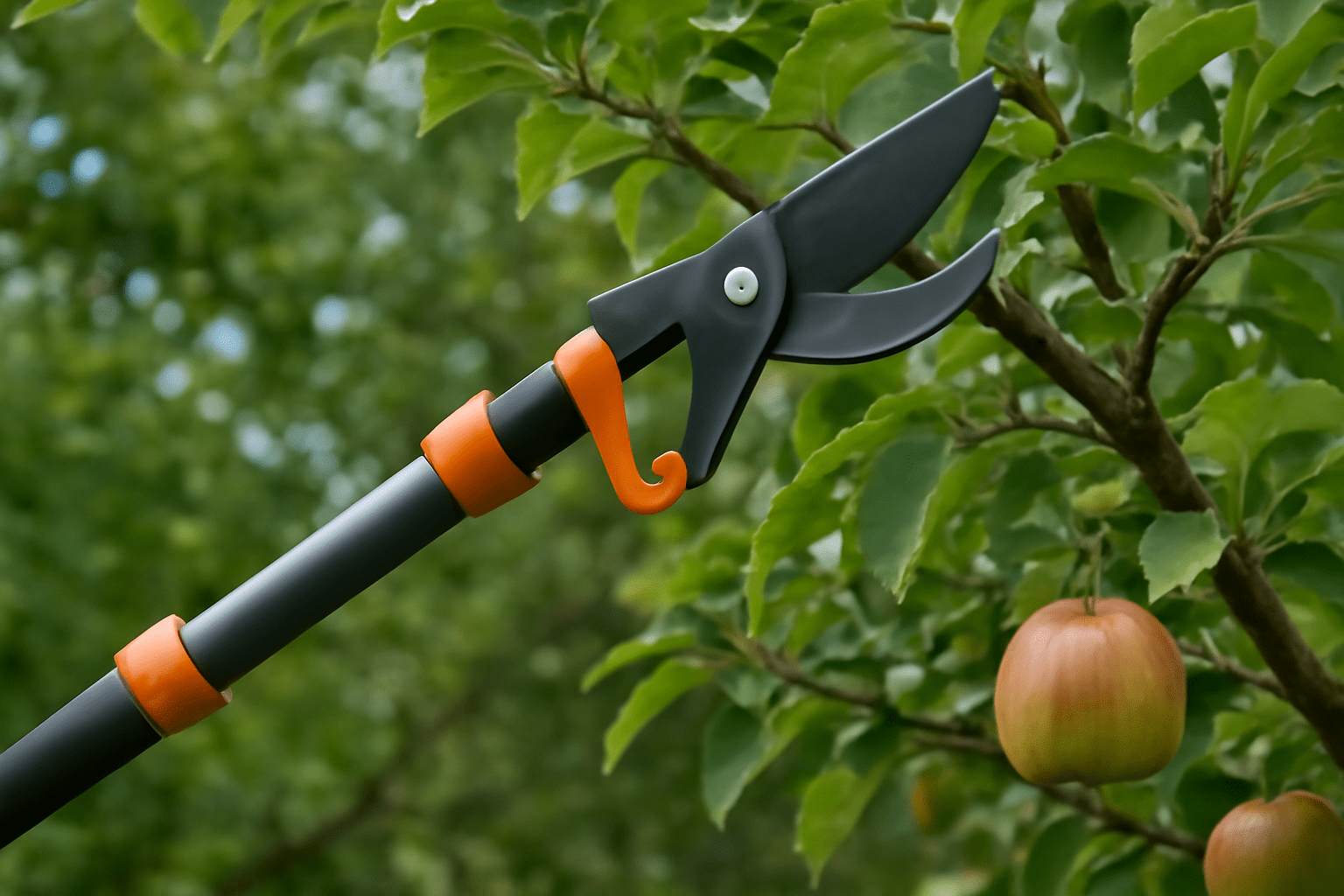
Features to Look For:
- Extendable pole 📏 for adjustable height ⬆️.
- Non-slip, ergonomic handle 🤲 for control 🛠️.
- Sharp cutting blades ✂️ or saw 🪚 at the end of the pole 🪓.
Recommended Brands: Fiskars, Corona.
🌿 Hedge Shears (for Shaping) ✂️
Best for: Shaping and trimming the overall structure 🌳.
Why You Need Them: If you want your tree 🌳 to maintain a particular shape 🔲 or just need to trim off excessive growth 🌿, hedge shears are the way to go 🏃♂️. They help create clean cuts ✂️ for aesthetics 🎨 and maintain a balanced look ⚖️.
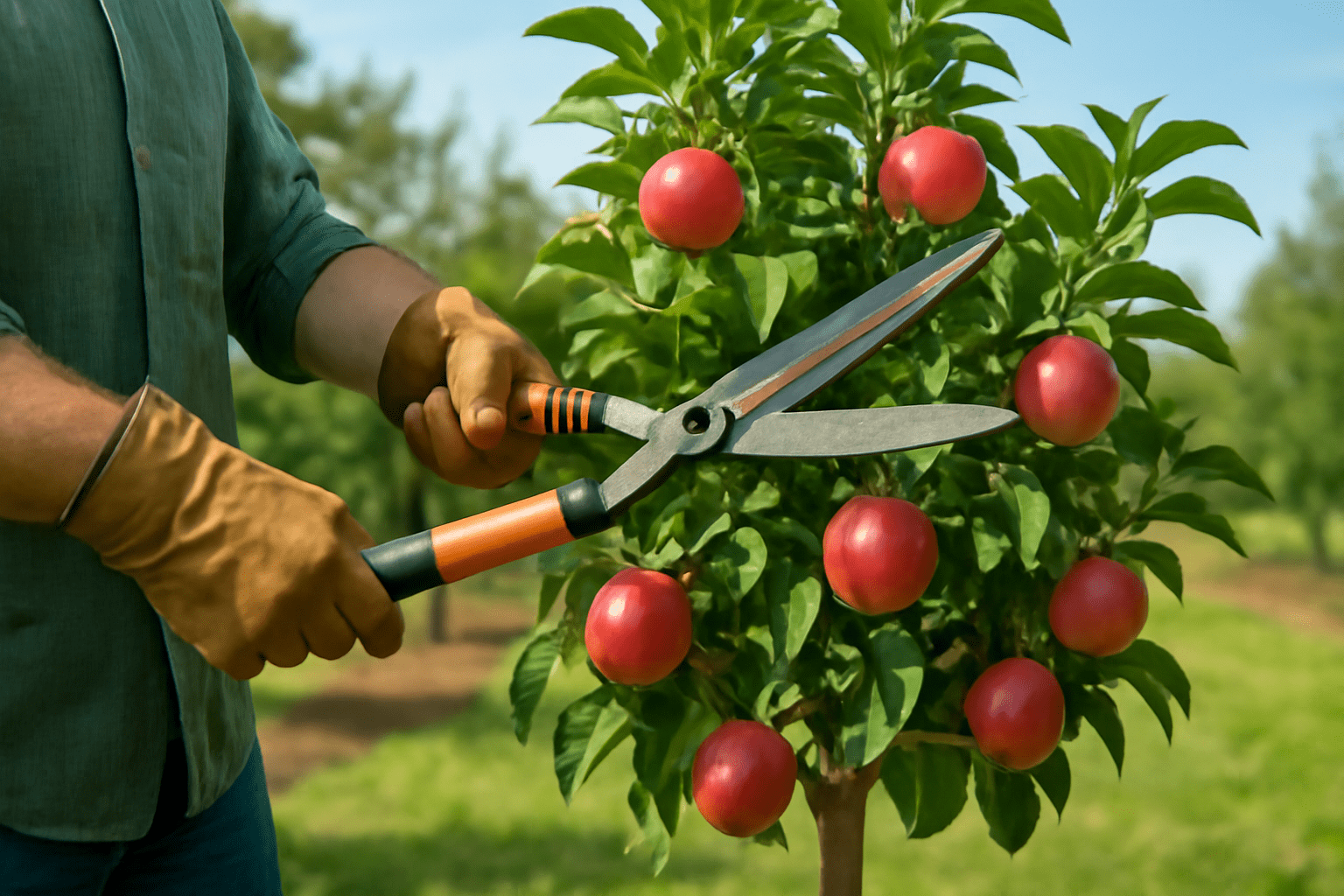
Features to Look For:
- Long, straight blades ✂️ for clean cuts 🔪.
- Lightweight 💨 and easy to maneuver 🤸♂️.
Recommended Brands: Fiskars, Gardena.
Each of these tools 🛠️ has a specific role to play 🧑🌾 in your apple tree 🌳 pruning routine 🗓️. By choosing the right one for the task at hand 🧰, you’ll make your pruning sessions 🧑🌾 faster ⚡, more effective 💪, and enjoyable 😌! 🌟
🔧🍏 How to Choose the Right Pruning Tools for Your Apple Tree 🍏🔧
Choosing the right apple tree pruning tools 🛠️ is crucial for achieving the best results 🏆 while minimizing effort ⚡. The right tools ✂️ make pruning easier 💪, safer 🦺, and more effective ✅. Here’s how to choose the best tools 🧰 for your apple tree 🌳, ensuring healthy growth 🌱 and maximum fruit 🍏 yield:
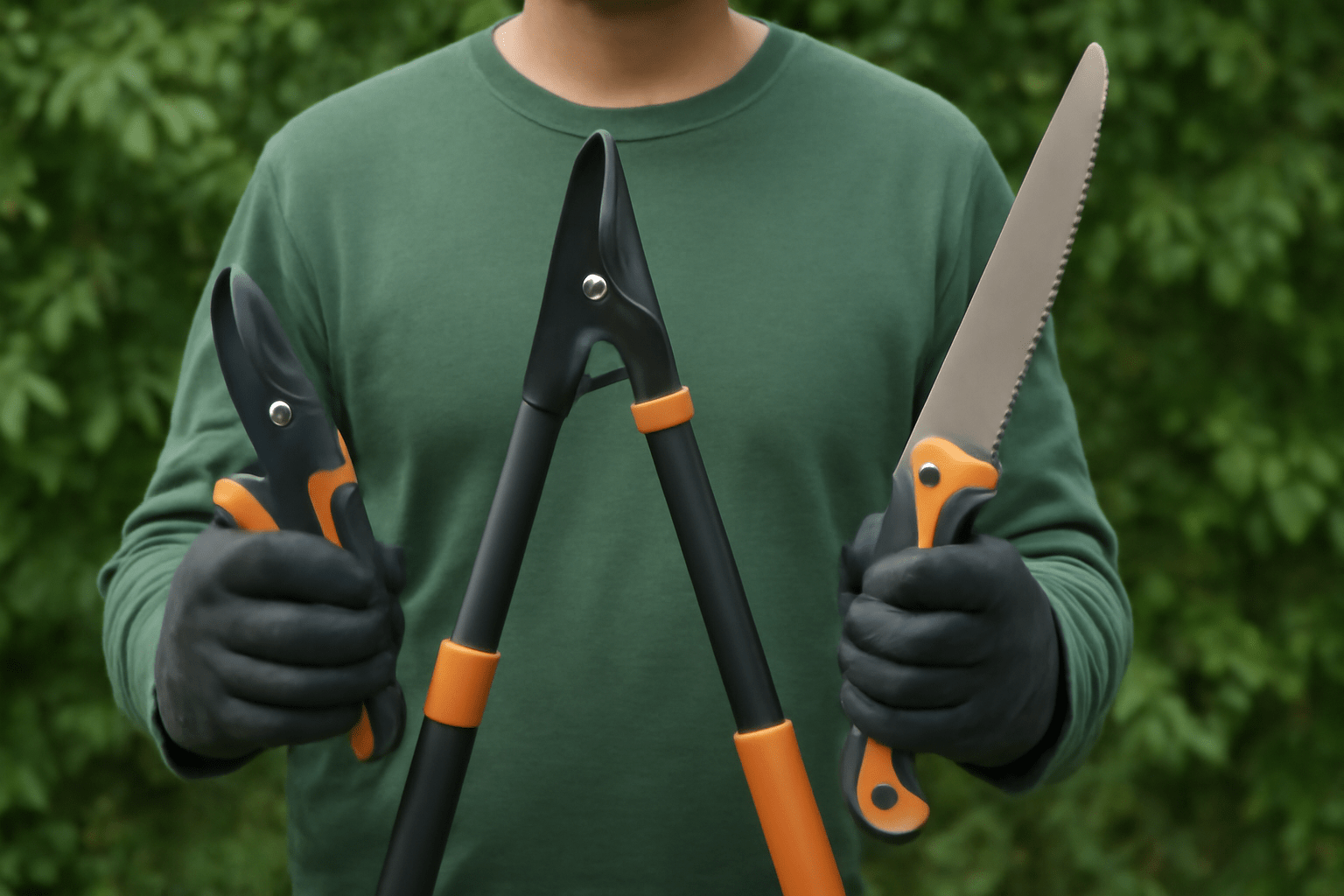
🌳 Consider the Size and Type of Your Tree 🌳
- Small Trees 🌱: If your apple tree 🌳 is young or small, pruning shears ✂️ or small loppers 🌿 should be enough for most tasks 🧑🌾. These tools are ideal for precise cuts 🧑🍳 on thinner branches 🌿.
- Mature Trees 🌳: For larger, more mature trees 🌳 with thicker branches 🌿, you’ll need tools like loppers 🌿, pruning saws 🪚, or pole pruners 🪓 to handle heavier cuts ⚡.
✂️ Think About the Thickness of the Branches 🌿
- Thin Branches (Under ¾ inch) 🌱: Use pruning shears ✂️. These are designed for precision 🎯 and are perfect for trimming small branches 🌿 and twigs 🌱.
- Medium Branches (Up to 2 inches) 🌳: Loppers 🌿 will give you the leverage 🏋️♂️ you need to cut through slightly thicker branches 🌳.
- Thick Branches (Over 2 inches) 🌳: For larger branches 🌳, a pruning saw 🪚 is essential 🛠️. It allows for smoother cuts ✂️ and greater control 🎯 over thicker wood 🌳.
🌿 Evaluate the Comfort and Ergonomics 🤲
- Handle Design 🌿: Look for tools 🧰 with ergonomic handles 🤲 to reduce strain 💪 during extended pruning sessions ⏳. This is especially important if you have a lot of trees 🌳 to prune or are working in difficult positions 🧑🌾.
- Weight ⚖️: Choose tools 🧰 that are lightweight 💨 enough to handle with ease, but still strong 💪 enough to handle the task 🛠️. Too heavy a tool 🧰 can cause fatigue 😓 and discomfort 💔.
- Grip 🖐️: Non-slip grips 🧤 help provide better control ⚙️ and prevent accidents ⚠️, especially if you’re working with wet or slippery branches 🌳.
🧰 Durability and Material 🧰
- Rust Resistance 🦠: Since you’ll be using these tools 🛠️ outdoors 🌳, it’s essential that they’re made from rust-resistant materials 🧪. Stainless steel 🛠️ or coated blades 🔪 are best for longevity 💪.
- Quality Construction 🏗️: Invest in high-quality tools 🧰 that can handle frequent use 🛠️ without compromising performance ✅. Well-constructed tools 🧰 are more efficient and will last longer 🔄.
🛠️ Reach and Accessibility 🪓
- Height of Your Tree 🌳: For trees 🌳 with high branches 🌿, pole pruners 🪓 will allow you to reach the tops of your trees 🌳 without a ladder 🪜, keeping you safe 🦺 while you prune ✂️.
- Easy Storage 🏡: Choose tools 🧰 that are easy to store and maintain 🛠️. Compact 🧳 and foldable options 📦 are great for saving space in your shed 🏠 or garage 🏡.
By carefully considering the size of your tree 🌳, the thickness of branches 🌿, and the comfort of your tools 🧰, you’ll be equipped with everything you need to prune effectively ✂️. With the right tools 🧰, you’ll enjoy healthier 🌱, more productive 🍏 apple trees 🌳 all year long! 🌿
✂️🍏 Step-by-Step Guide on How to Prune Your Apple Tree 🍏✂️
Pruning ✂️ your apple tree 🌳 might seem like a daunting task 😰, but with the right tools 🛠️ and approach 🔧, it can be a simple and rewarding experience 🏆. Here’s a step-by-step guide 📋 to help you prune ✂️ your apple tree 🌳 like a pro 🧑🌾 and ensure it thrives 🌱 year after year 🌞.
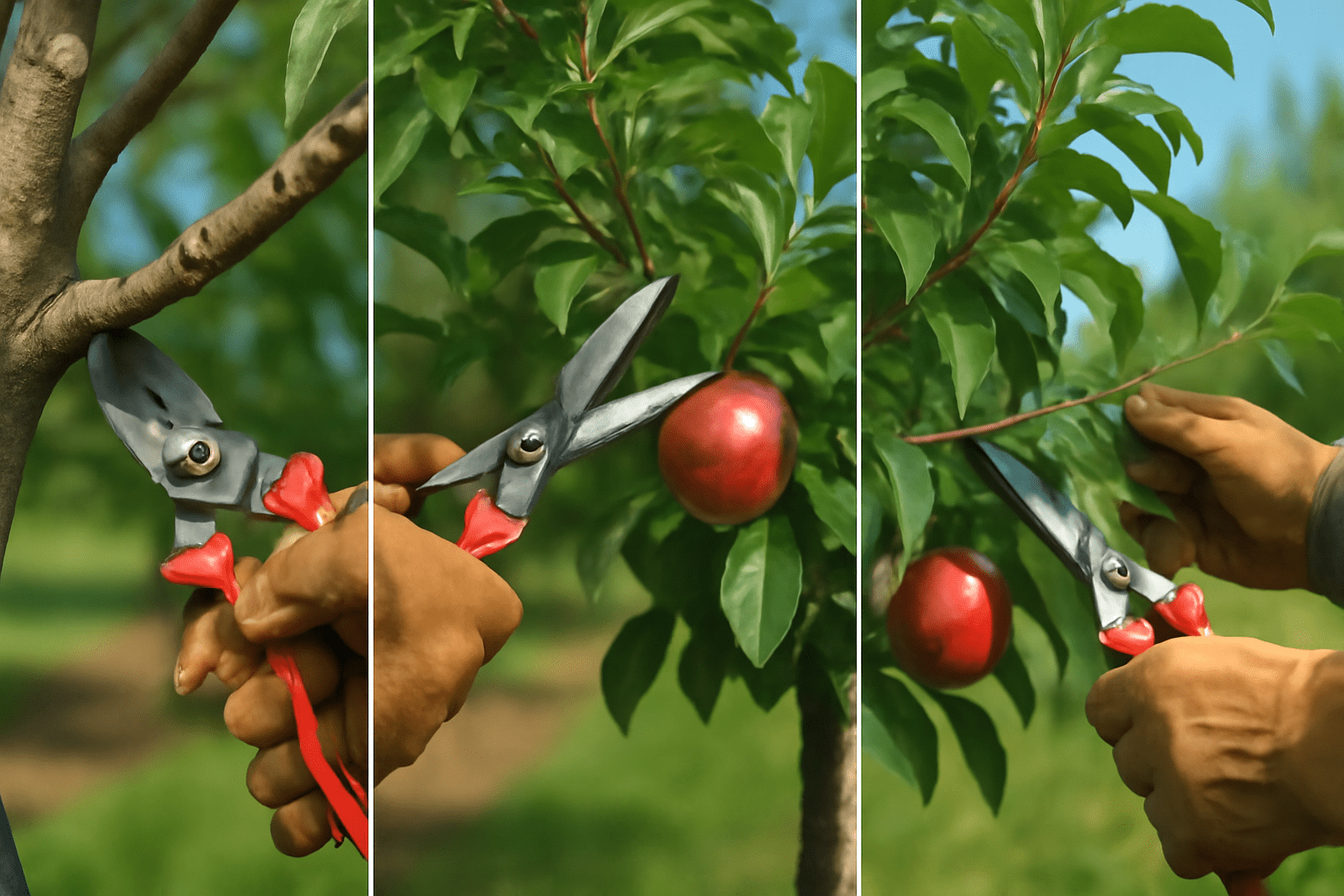
🌱 Step 1: Inspect Your Tree 👀
Before you start cutting ✂️, take a good look 👀 at your tree 🌳. Look for:
- Dead or Diseased Wood 🦠: These branches 🌿 are typically dark, brittle, or discolored 🍂. Removing them early helps prevent the spread of disease 🦠.
- Damaged or Broken Branches 🌳: If you spot any, they should be removed ✂️ to avoid further harm to the tree 🌳.
- Crossing or Rubbing Branches 🌿: Branches 🌿 that rub against each other can cause wounds 💔 that invite pests 🐜 and diseases 🦠. Remove one to improve airflow 🌬️.
🌳 Step 2: Make the Cuts ✂️
Now that you’ve identified what needs to go 🧑🌾, it’s time to prune ✂️:
- Small Branches 🌱: Use your pruning shears ✂️ to remove small, dead ❌, or weak branches 🌿. Make cuts just above a bud 🌱, at a 45-degree angle 🔽, to encourage healthy new growth 🌱.
- Medium Branches 🌳: For branches 🌿 around 1-2 inches thick 🌳, grab your loppers 🌿. Cut at a slight angle 🔽, leaving a small stub 🌱 that can heal naturally 💪.
- Thick Branches 🌳: For anything thicker than 2 inches 🌳, you’ll need your pruning saw 🪚. Always make cuts outside the branch collar (the raised area around the base of the branch) to avoid damaging the tree 🌳.
🍏 Step 3: Focus on the Center of the Tree 🌳
Pruning the center of the tree 🌳 is crucial for good airflow 💨 and light penetration 🌞:
- Remove Any Branches Growing Inward 🌿: These can block sunlight ☀️ and air 🌬️ from reaching the inner parts of the tree 🌳, which hinders fruit 🍏 development.
- Open Up the Center 🌳: If your tree 🌳’s canopy is too dense 🌳, thin out some of the central branches 🌿. This allows sunlight ☀️ to reach all parts of the tree 🌳 and improves overall growth 🌱.
🌿 Step 4: Thin Out Overcrowded Branches 🌱
As the tree 🌳 grows, some branches 🌿 will start competing for space and resources 🌱. To help your tree 🌳 thrive 🌱:
- Remove Competing Branches 🌿: Look for branches 🌿 that cross each other ↔️ or grow too close together 🌱. Remove the weaker of the two to ensure the remaining branches 🌿 have enough space to grow 🌱.
- Shape the Tree 🌳: Trim back any overly long or unruly branches 🌿 to maintain a balanced shape ⚖️. This is especially important for maintaining a strong framework 🏗️ for future fruit 🍏 production.
🍎 Step 5: Dispose of the Cut Branches 🌿
After you’ve finished pruning ✂️, it’s important to clean up 🧹:
- Remove Fallen Debris 🍂: Any diseased 🦠 or damaged wood 🌿 should be disposed of properly ✅. Don’t leave it near the base of the tree 🌳 to avoid spreading infections 🦠.
- Sanitize Your Tools 🧰: Clean 🧼 and sharpen 🔪 your pruning tools 🧰 to keep them in good condition 🏆 for the next pruning session 🗓️.
By following these steps 🧑🌾, you’ll ensure your apple tree 🌳 is not only healthy 🌱 but also positioned for better fruit 🍏 production. Pruning ✂️ might take a little time ⏳, but the results 🏆 will speak for themselves 📢 as your tree 🌳 grows stronger 💪 and more productive 🍏 year after year 🌞! 🌱
🔧🌿 Maintenance and Care of Your Pruning Tools 🌿🔧
Proper care 🧑🌾 of your apple tree pruning tools 🛠️ ensures they stay sharp 🔪, effective 💪, and durable ⏳, making your pruning tasks ✂️ easier and more efficient ⚡. Here’s how to maintain your tools 🧰 to keep them in top shape 🌟:

🧽 1. Regular Cleaning 🧼
Why Clean 🧴: After each use 🛠️, your pruning tools 🧰 can accumulate sap 🍯, dirt 🌍, and plant debris 🍂, which can cause rust 🦠 and make cutting ✂️ less efficient.
How to Clean 🧽: Wipe down the blades 🔪 with a clean cloth 🧴 after every use 🧑🌾 to remove sap 🍯 and dirt 🌍. For stubborn residue 🏚️, soak the blades 🔪 in warm, soapy water 💦, then scrub with a brush 🧹.
Bonus Tip 💡: Dry your tools thoroughly 🔥 to prevent rusting 🦠, especially on metal parts 🔩.
✨ 2. Sharpening Your Blades 🔪
Why Sharpen 🧠: Dull blades 🔪 can damage your apple tree 🌳 and make cutting ✂️ more difficult, leading to uneven cuts ✂️ that may invite diseases 🦠.
How to Sharpen 🔧: Use a sharpening stone 🪚 or a file 🗜️ to keep the blades 🔪 sharp. For pruning shears ✂️, use a fine grit file 🧳 to carefully sharpen both sides of the blade at the same angle 🔄 as the original edge 🔪. For loppers 🌿 and saws 🪚, follow the manufacturer’s instructions 📜 to keep them razor-sharp 🦈.
When to Sharpen 🗓️: Sharpen your tools once a season 🗓️ or whenever they start to feel less effective ⚡ during pruning ✂️.
🛢️ 3. Oiling for Smooth Operation 🧴
Why Oil 🛢️: Oiling 🧴 the moving parts 🪛 of your tools 🧰 helps prevent rust 🦠 and keeps them functioning smoothly 💨.
How to Oil 🛢️: Apply a light layer of oil 🧴 (vegetable oil 🌱 or motor oil 🚗 works well) to the hinges 🔧 and moving parts 🔩 of your shears ✂️, loppers 🌿, and saws 🪚. Wipe off any excess oil 🧴 with a clean cloth 🧼 to avoid attracting dirt 🌍.
Bonus Tip 💡: Regular oiling 🛢️ extends the life 🔋 of your pruning tools 🛠️ and ensures they continue to work efficiently ⚡.
🌟 4. Proper Storage 🏡
Why Store Properly 📦: Storing your tools 🧰 correctly can prevent damage 🛑 and keep them in working condition ⚙️ for longer ⏳.
How to Store 🧰: Keep your tools 🛠️ in a dry place 🏡, like a tool shed 🏚️ or garage 🚗, to prevent moisture buildup 💧 that could cause rust 🦠. Hang your pruning tools 🛠️ on hooks 🪝 or store them in a toolbox 📦 to keep them safe from being dropped 🚫 or damaged 🛑.
Bonus Tip 💡: During the off-season 🥶 (winter ❄️), store your tools 🛠️ indoors 🏡 to avoid exposure to extreme weather conditions 🌪️.
🔒 5. Tightening and Adjusting 🔧
Why Tighten 🧩: Loose parts 🔩 can cause your tools 🧰 to function poorly 🐢 or even break 💔.
How to Tighten 🔧: Periodically check 🔍 the bolts 🔩, nuts 🌰, and screws 🧰 on your tools 🛠️. Tighten them as necessary 🔧 to ensure everything stays secure 🔒.
Bonus Tip 💡: If your pruning tools ✂️ have an adjustable tension feature ⚙️ (like shears ✂️ or loppers 🌿), make sure it’s set correctly to maintain optimal cutting performance 🔪.
By taking these simple steps 🧑🌾 to clean 🧽, sharpen 🔪, oil 🛢️, and store 🧰 your apple tree pruning tools 🛠️, you’ll not only extend their lifespan 🔋 but also improve their performance 💥, making your pruning tasks ✂️ more enjoyable 😊 and efficient ⚡. Regular maintenance 🧑🌾 helps you get the best results 🏆 for your apple tree 🌳 and ensures your tools 🧰 are always ready for the job 🔧! 🌱✨
🚫🍏 Common Mistakes to Avoid While Pruning Apple Trees 🍏🚫
Pruning apple trees 🌳 is essential for their health 🏥 and productivity 🌱, but it’s easy to make mistakes ❌ if you’re not careful. To help you get the best results 🏆, here are some common pruning mistakes 🐜 to avoid:

❌ 1. Over-Pruning ✂️
Why It’s a Problem: Cutting away too much of the tree 🌳 can stress it out 😰, reduce fruit 🍏 production, and stunt growth 🌱.
How to Avoid It: Focus on removing dead, diseased 🦠, or damaged wood 🍂, and only prune ✂️ a small portion of the tree 🌳 each year. Aim for a balanced shape ⚖️ rather than cutting excessively.
Tip: A good rule of thumb 🧠 is to never remove more than 20% of the tree’s branches 🌿 in one pruning session ✂️.
❌ 2. Pruning at the Wrong Time ⏰
Why It’s a Problem: Pruning at the wrong time ⏰ can damage the tree 🌳 and interfere with its natural growth cycle 🔄.
How to Avoid It: The best time ⏰ to prune apple trees 🌳 is during the late winter ❄️ or early spring 🌷, while the tree 🌳 is still dormant 💤. Pruning during the growing season 🌞 or fall 🍂 can leave the tree 🌳 vulnerable to disease 🦠 and pests 🐜.
Tip: If you have to prune in the summer 🌞, focus only on removing dead ❌ or diseased 🦠 branches 🌿.
❌ 3. Cutting Too Close to the Trunk 🌳
Why It’s a Problem: Cutting too close to the trunk 🌳 can leave the tree 🌳 vulnerable to infections 🦠, as it creates a large wound 💔 that’s harder to heal 🩹.
How to Avoid It: Always cut just outside the branch collar 🪶 (the raised area where the branch 🌿 meets the trunk 🌳). This allows the tree 🌳 to heal naturally 🌱 without exposing it to infection 🦠.
Tip: When using pruning shears ✂️ or saws 🪚, leave a small, healthy portion 🌱 of the branch collar 🪶 to ensure the tree 🌳 can heal properly.
❌ 4. Not Using the Right Tools for the Job 🛠️
Why It’s a Problem: Using inappropriate tools 🛠️, like pruning shears ✂️ for thick branches 🌿, can result in rough cuts 🪚 that damage the tree 🌳 and create openings for disease 🦠.
How to Avoid It: Choose the right tool 🛠️ for each job 👨🌾. Use pruning shears ✂️ for small branches 🌿, loppers 🌿 for medium-sized branches 🌳, and a pruning saw 🪚 for larger branches 🌳.
Tip: Always ensure your tools 🛠️ are sharp 🔪 and well-maintained 🧰 to make clean, efficient cuts 🔪.
❌ 5. Leaving Stubs or Ragged Cuts 🌳
Why It’s a Problem: Leaving stubs 🍂 or making uneven cuts 🪚 can cause damage to the tree 🌳 and make it harder for the wound 💔 to heal properly.
How to Avoid It: Always make cuts ✂️ at a slight angle 🔽 just above a bud 🌱, leaving a clean, smooth cut 🔪. Avoid jagged or ragged cuts ✂️, which can expose the tree 🌳 to pathogens 🦠.
Tip: Invest in high-quality pruning tools 🛠️ that help you make clean, precise cuts ✂️ every time 🕰️.
❌ 6. Pruning Without a Plan 🗺️
Why It’s a Problem: Pruning without a clear idea of what you’re trying to achieve 🎯 can result in an unbalanced tree 🌳 and reduced fruit 🍏 yield.
How to Avoid It: Before you start pruning ✂️, step back 🦵 and assess the tree 🌳. Decide which branches 🌿 need to go ❌ and which should stay to create a strong 💪, healthy structure 🌳.
Tip: If you’re unsure 🤔, follow the “3D” rule 🧠—remove anything that’s Dead ❌, Diseased 🦠, or Damaged 💔, and thin out any crowded branches 🌿.
By avoiding these common mistakes ❌, you’ll ensure that your apple tree 🌳 grows strong 💪, healthy 🌱, and produces the best possible fruit 🍏. Proper pruning ✂️, done at the right time ⏰ and with the right tools 🛠️, is key 🔑 to a thriving apple tree 🌳 and a successful harvest 🍏! 🌱🍎
:
🌟🍏 Final Thoughts 🍏🌟
Pruning ✂️ your apple tree 🌳 is a crucial task 🛠️ that, when done right ✅, pays off in healthier growth 🌱, more fruit 🍏, and a beautifully shaped tree 🌳. By using the proper apple tree pruning tools 🛠️ and following the right techniques 🔧, you can ensure your tree 🌳 thrives season after season 🗓️. From choosing the right tools 🧰 for the job 👨🌾 to avoiding common pruning mistakes ❌, each step you take helps create a healthier 🌱, more productive tree 🍏.

Remember 🧠, pruning ✂️ is not just about cutting ✂️—it’s about giving your tree 🌳 the best chance ✨ to grow strong 💪, fight off pests 🐜, and produce an abundance 🌿 of delicious apples 🍏. With the right knowledge 📚 and the right tools 🧰, you’ll be able to prune confidently ✂️ and maintain your apple tree 🌳 for years to come 🕰️.
Happy pruning ✂️, and here’s to a flourishing apple tree 🌳! 🍏🌿
Frequently Asked Questions (FAQ)
What are the best pruning tools for apple trees?
The best tools for pruning apple trees include pruning shears for small branches, loppers for medium branches, and a pruning saw for larger branches. Pole pruners are essential for reaching high branches, while hedge shears help maintain the tree’s shape. Each tool serves a specific purpose based on branch size and accessibility.
When is the best time to prune apple trees?
The ideal time to prune apple trees is during their dormant season, usually in late winter or early spring before new growth begins. Pruning at this time minimizes stress on the tree and helps prevent the spread of diseases. Avoid pruning in late fall or during the growing season to prevent damage to the tree.
How often should I prune my apple tree?
Apple trees should be pruned annually, typically in the late winter or early spring. Regular pruning helps maintain the tree’s health, encourages stronger growth, and increases fruit production. However, if you have a very young tree, lighter pruning may be needed every other year until it matures.
What’s the difference between loppers and pruning shears?
Pruning shears are compact, handheld tools designed for cutting small branches, usually under ¾ inch thick. Loppers, on the other hand, have longer handles and are used for cutting larger branches (up to 2 inches thick). Loppers provide more leverage and power, making them suitable for medium-sized branches.
Can I use regular garden scissors for pruning apple trees?
While regular garden scissors might work for very small branches, they’re not ideal for apple tree pruning. They lack the sharpness, durability, and leverage that pruning shears offer. Specialized pruning tools ensure cleaner cuts and reduce damage to the tree.
How do I maintain my pruning tools?
To maintain your pruning tools, clean them after each use to remove sap and dirt. Sharpen the blades regularly using a sharpening stone or file to ensure they stay effective. Apply oil to moving parts to prevent rust and store them in a dry, safe place to prolong their lifespan.
What size of branches can pruning shears cut?
Pruning shears are designed to cut small branches, typically up to ¾ inch in diameter. They are perfect for trimming twigs, dead wood, and small growth. For thicker branches, loppers or a pruning saw would be more appropriate.
How do I avoid damaging my apple tree while pruning?
To avoid damaging your apple tree, make sure to prune carefully by cutting just above a bud and at a 45-degree angle. Use the right tools for each branch size and never cut too close to the trunk or remove too much wood. Always remove dead, diseased, or damaged branches to improve the tree’s overall health.





